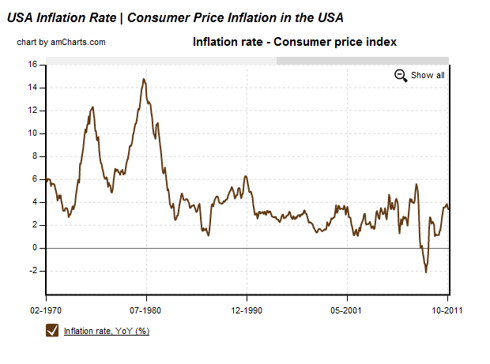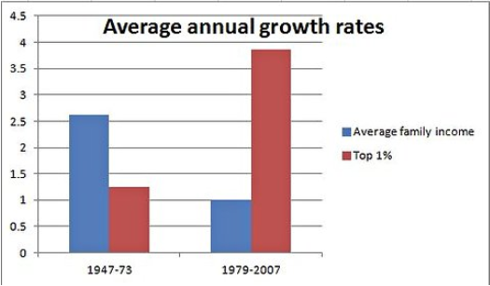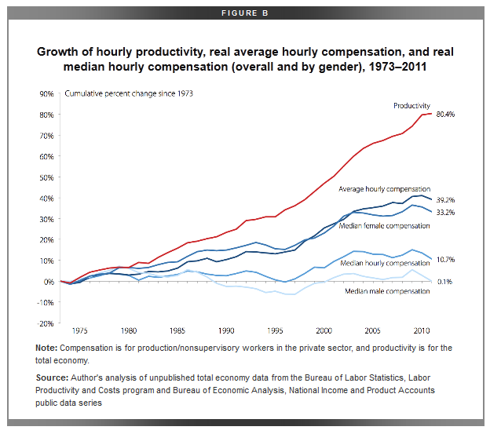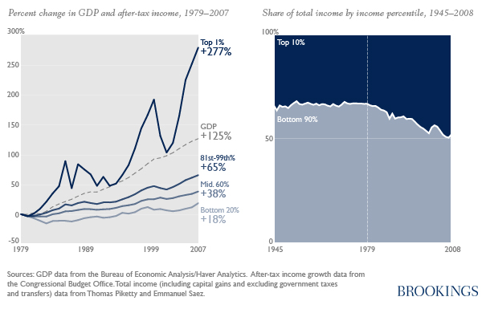'Festive, Righteous Anger': Occupy Makes May-Day Comeback With Massive Demonstrations
Midtown is a great place for chanting; your voice echoes off the tall buildings and you can hear it blocks away. Even better for marching bands, bells and whistles. There may not actually be 99 pickets, but midtown Manhattan is clogged with them in the morning, and they're inside the heads of the people on the street--I walk past a couple discussing our "cruel," unequal society as I hurry from picket to picket.
I made it to Bryant Park a few minutes after eight in a haze of rain, and found a crowd of around 100 huddled under their umbrellas or the ones at tables in the park. The Rude Mechanical Orchestra were clustered around their instruments but not playing, and Occupiers chatted with one another.
My first picket stop was at the New York Times building, where the United Auto Workers (UAW) were picketing under a lovely awning in support of the National Organization of Legal Services Workers (UAW Local 2320). The lawyers and legal support staff of Legal Services NYC provide free legal aid to New York's low-income folks who need support--they help fight evictions, support the unemployed, work on benefits for the disabled, and more. They're facing cutbacks from their board, who want them to give back part of their healthcare benefits--not to mention cuts to the services they provide.
"We make next to nothing," a legal services worker told me, pointing out that her benefits allow her to do a low-paid service job and take care of herself and her family. None of the cuts have hit management. Their target for the day's picket was Michael Young, the vice chair of the Board of Directors at Legal Services NYC, who has been the point person in negotiating with the union.
As we stood talking, the Rude Mechanical Orchestra and a small march rolled in, playing "Which Side Are You On?" and thrilling the workers, who didn't seem terribly connected at first to the larger May Day celebrations. The picket line turned into a dance party, and the band played along with chants of "Hey hey rich boy, my job is not your toy" and "We're legal services for the poor, fired up won't take no more."
From Twitter, colleagues Allison Kilkenny, John Knefel and I heard reports of arrests at the Bank of America tower, which was surrounded by barricades when we arrived but quiet at the moment, so I moved on to News Corp headquarters, where the ticker outside the building warned "Occupy plans to shut down city today, gathering at Bryant Park." It made a lovely backdrop for the lively picket line, featuring several members of OWS's Direct Action working group as well as banners and activists from Picture the Homeless, SEIU, VOCAL-NY (including Wayne Starks, whom I spoke with on Tax Day), and other local groups.
As they marched, the crowd repeated the crimes of Rupert Murdoch and News Corp--not only "Murdoch spies," a reference to the phone hacking scandal in the UK, but "News Corp called for closing HIV food pantries, housing for people with AIDS."
From News Corp, I moved on to Chase, where a small but determined band was chanting "Save our homes, modify loans!" outside the branch on 47th and Madison, but no one had made it to the main headquarters, location of many an Occupy event. I saw a march rounding the corner as I headed the other way, trying to catch a march that had left News Corp for the headquarters of the Paulson Group, one of the world's largest hedge funds, but instead I crossed paths with a small march flying an anarchist flag, singing "Ain't no power like the power of the people because the power of the people don't stop."
The marchers were young, mostly white, but the one arrest came when a young black man, whose name, I was told, was Gregory Walker, was slammed against a glass window and thrown to the ground--I didn't witness what happened to cause his arrest, but I did watch him loaded into a police van and the crowd spontaneously broke into "Solidarity Forever."
Back at Bryant Park, the scene had picked up and the feeling was more Liberty Square than grim determination. A woman mic-checked to offer belly dance lessons, and I chatted with Betsy Fagin at the Library, back in action. Screenprinters had the next table over from the Library, and were churning out prints of a Guy Fawkes mask decorated with spring leaves. I caught up with Pam Brown and Suzanne Collado of the Occupy Student Debt campaign, who had been at their own picket outside of NYU, protesting student debt and the university's expansion plan (financed with students' money).
The park is also serving as a staging location for marches. I spoke with organizers pulling together an immigrant worker justice march, departing at 11 to his Praesidian Capital, Wells Fargo, the Capital Grille, Chipotle and Beth Israel, in support of workers trying to organize, Wells' support for anti-immigrant legislation through ALEC, wage theft and discrimination, the Coalition of Immokalee Workers' Fair Food Campaign, and laundry workers who clean hospital sheets, respectively.
On the way out, I spoke with Jerry, who told me about the Summer Disobedience school that will be held every Saturday in Bryant Park, training activists in pickets, marches, street theater and more.
-- Sarah Jaffe
Wildcat Strike, NYC
The Wildcat Strike -- designed to bring together non-unionized, or unionized workers whose unions had not approved the strike -- was one of the unpermitted actions of May Day. Protestors and strikers came at the risk of their own arrests and the authorities had the right to "do whatever they want."
I arrived at Sara Roosevelt Park half an hour early. There were already 50 or 60 police huddled on the corner of Second Avenue and East Houston. At that point, there were maybe 10 protestors.
"I feel like they're the ones that should be protesting and we should be the cops," I joked to one of the few other protesters in the park.
"I know. I wish we could pull out our batons and tell them that they're blocking the sidewalk," he replied.
A few minutes later, fellow protesters and marches streamed in from Brooklyn, fresh from having walked across the Williamsburg Bridge. The police began to subside, merely observing the demonstrators as they played music, held signs and chanted.
Though the crowd was mostly young and though not exclusively white, far from racially diverse, their occupations -- and reasons for showing solidarity at the wildcat march in particular -- were vastly different.
"I am a non-union metal worker, working a pretty low range for my skill set," said Rachel, a young woman holding a foil flag as an artistic allude to metal workers. "I'm here to represent those who are actually in labor who don't want to be part of a permitted anti-capitalist march and stand in solidarity with my fellow workers who might be afraid or can't afford to be here."
Gregory, a doctoral student and graduate teaching assistant at SUNY Stony Brook College also came to use the wildcat strike as an opportunity to express himself in protest.
"I'm a union member, I'm a public employee of the state--and as a public employee, we are legally not allowed to strike. The wildcat strike provides a space for those of us who can't strike for whatever reason to still express ourselves in protest."
Gregory went on to talk about how his role as an instructor, and a member of the Graduate Student Employees Union made him align himself more with student strikers than other instructors. As students face state budget cuts, and increasing tuition and debt, he sees his role as an instructor as part of the larger struggle around education rather than precarious labor.
"I make $15,000 a year -- I should be striking for myself, but actually I'm striking for my students."
After a fairly civil 20 minutes of chatting, singing, live music and navigating the march, a march began. The first man who tried to even so much as leave Sara Roosevelt Park was immediately tackled to the ground and arrested by the NYPD. After digesting the chaos, demonstrators decided to run en masse to the south end of the park, many jumping over the railings to avoid the police and began marching south toward Chinatown.
The police followed, a parade of 30 riot cops on mopeds following strikers on foot on the sidewalk and on bicycles in the streets. Throughout the crowded, but peaceful march, vans and other arrest vehicles began to follow the mopeds, indicating imminent arrests.
Ironically, the extreme police presence was blocking traffic and inconveniencing the flow of the city far more than the strikers.
Once the march reached Houston and Lafayette -- almost a complete square from where it began -- the cops donned their riot gear and took out their batons. Protesters were kettled onto the sidewalks, spilling off of them and threatened if even so much as a foot was in the street. One nicely dressed man, without provoking anyone, was arrested and thrown to the ground.
After being halted by the police, the march continued up Broadway -- ever racing riot cops to resist being surrounded, the march continued and ended at Washington Square Park.
-- Anna Lekas Miller
Free University: Madison Square Park, noon-3pm
The sun came out over Madison Square Park as OWS Free University kicked off. Forgive the pun, but the class war was definitely in session. Professors and experts gathered groups around them throughout the benches and pathways of this park as midtowners walking by stopped to look. There was a lesson on "horizontal pedagogy"--or how to teach without hierarchy--talks by noted leftist thinkers Chris Hedges and Francis Fox Piven, a discussion about native/indigenous resistance and another about gender constructs, and most pertinently, a student debt teach-in. One guy was even leading a class on "ancient political philosophy" and I thought about the Athenian forum.
This action was meant to--and did--accomplish two goals. First, it recaptured the "public square" aspect of Zuccotti Park occupation and other encampments, that sense of people radically coming together and talking to each other about major, transformative ideas without boundaries or rules. Secondly, it demonstrated by example a principle of communal, free, shared and sharing education without tuition or fees, a rejoinder to the rising tuition costs at institutions across the country.
As the "class" sessions came to an end under the sunshine, demonstrators talked in clusters, took pictures and gathered around the park's central fountain. And then the sound of chants, whistles and guitars began to float over the park.
Protesters rushed over to Broadway to see the advancing "guitarmy" march--a musical, un-permitted, wild walk down from Bryant Park led by Tom Morello, its members spilling out onto the sidewalks and the center of Broadway flanked by the NYPD. Cheers and the sound of musical instruments ensued as the march continued on its way down toward the afternoon's destination: Union Square.
-- Sarah Seltzer
Global Justice
The hundreds upon hundreds of protesters streaming into Union Square on May Day were greeted by an elaborate paper “maypole.” There was no need for explanation, as the top of the maypole read, “All our grievances are connected”—another way of saying 'We are the 99%.'"
Walk a couple hundred feet in the park, and there's an Occupy Wall Street group that fervently believes that maxim: the Occupy Wall Street global justice working group. A contingent of about 30 people affiliated with the working group had gathered before the union-heavy permitted march from Union Square to Wall Street. The reason? To “declare our commitment to resist and to end wars at home and abroad,” in the working group’s own words.
The names Iran, Palestine, Egypt and more were written on the activists' placards. They joined thousands of demonstrators for a march that capped off a day full of actions highlighting economic inequality, police brutality, immigrant rights and more. In the streets, NY-based Palestine solidarity activist Dave Lippman provided the guitar-strumming while others sang songs. “When you shop and when you dine,” they sang, “stand up for Palestine”—a plea for boycotts of Israeli products.
Activists from the global justice working group are full of knowledge and experience about struggles from Bahrain to Egypt to Palestine. It includes organizers involved with CodePink, the War Resisters League, Adalah-NY and more--key groups working on peace and justice issues in the city. They want to bring their knowledge to the broader world of Occupy Wall Street activism. The march, and songs about struggles here and abroad, were one way of doing that.
“Very often in OWS you get people who don’t know what’s going on across the water,” explained Udi Pladott, an activist and former soldier in the Israeli army. “We’re trying to inject global issues into Occupy.” Toward that goal, the working group has sponsored events on Bahrain and held a teach-in on the global tear-gas industry.
“We want to make connections between the war on the poor here and wars abroad,” said Nancy Kricorian, an organizer with CodePink. Conversations with working group participants made clear what those connections are: a system that rewards militarism with profits while demanding austerity for the poor.
Apart from Bahrain and Palestine, the specter of a war with Iran, and organizing to stop that possibility, was very much on the minds of participants. A number of signs at the march read “No to sanctions. No to war. No to state repression.” I spoke with Manijeh Nasrabadi, a PhD student at New York University and an organizer with Havaar, an Iranian group that now works with the global justice working group, for more on this subject.
“There are people in Iran organizing against the same things. They have a government pushing neoliberal policies,” she explained. Nasrabadi also criticized the tendency of some on the left to reflexively back Iran’s leaders since they are in opposition to the West, even as the regime violently cracked down on dissent. “There is a third way: global solidarity,” that isn’t morally compromised, Nasrabadi said.
I asked Nasrabadi what the connection was between Iran, the US and the Occupy movement. Answers abound to that question.
But she had a simple answer that helps explain the importance of the global justice working group: “If bombs fall, it would derail thinking about class.”
-- Alex Kane
Tom Morello and the Guitarmy, Union Square
Under unexpectedly sunny skies, thousands converged upon Union Square yesterday afternoon, their numbers growing as the Tom Morello-led “Guitarmy,” flanked by their acoustic axes, marched in from Bryant Park. One of the only spots with a city permit, the Square was the destination for the day’s live music, but it also served as a safe space for protesters unwilling or unable to risk arrest. As such: the undocumented faction came out in droves, and it became a symbolic place where unions and Occupy joined forces with immigrants' rights movements. People carried signs reading, “Amnesty Para Todos,” “Trabajando y Educación Para Todos,” “Stop the Raids” and, most crucially, “No a la guerra, ni a la militarización de la frontera.” It’s important not to forget the bigger picture: the border debates are an extension of our country’s war-obsession, and solve no problems.
But the overall spirit at Union Square was one of joy and enthusiasm and united strength. A large stage was set up to accommodate the performers and speakers and the message was clear: through art, activism can glean both power and relief. At around 4pm, the show started with the beloved Tom Morello, aka the Nightwatchman, aka guitarist in Rage Against the Machine (which we recently learned is Paul Ryan’s favorite band, and who we hope will act on the knowledge by writing a song about him).
Because of the abundance of artists and speakers in the lineup, each act only got to perform two songs, and Morello used his time effectively. Playing after a speaker announced, “We’re here to announce that another world is not only possible, but on her way,” Morello brought his 20-person Guitarmy onstage to a fired-up crowd ready to party for justice. He kicked off his set with a singalong of “World Wide Rebel Songs,” which pays homage to union classics, and got thousands of protesters singing the chorus (and freaking out when he played the harmonica, because the proles, apparently, love a harmonica).
Then he noted that, were Woody Guthrie alive, he’d be 100, and that if he were still with us, he’d be headlining the event. Morello’s next song? “This Land is Your Land,” which resulted in another joyous singalong and pogo session. His parting words: “Take it easy, but take it.” Morello’s performance was followed by a speech by Emily Park, who announced herself as an undocumented student at CUNY. “DREAMers like me are the future of later,” she said, and advocated the New York DREAM Act that’s currently underway at the state level. Then Joyce Lyon, of the Domestic Workers union, reminded us that, “The thousands of you standing here are the engines that make the economy run,” whether documented or not.
Their speech was followed by a performance by a multinational Latin jazz band representing Local 802, the musician’s union, during which the drummer protested the elimination of 31 multicultural categories at the Grammys. (Including the award for best Latin jazz album and best Native American album, among others.) The band was followed by performances by rap trio Das Racist (full disclosure: my family members are in the group), noise-pop musician Dan Deacon, and rapper Immortal Technique, all of whom celebrated the energy and presence of the thousands in the crowd. A
While the focus was certainly on the arts, the most salient point of the rally was made by a speaker later in the day, who reminded us that the Supreme Court is on the cusp of legalizing Arizona’s immigration law, SB 1070, and that it was up to us to stand against similar racist laws like it. “This is not an immigration issue,” she said. “This is a people issue.” The crowd was penned in by barricades, guarded by ever more police as the protest geared up to march downtown, but her message was more powerful than the city’s ominous message. Immigration is a people issue, and this was a joyous, inspiring peoples’ protest.
-- Julianne Escobedo Shepherd
Marching from Union Square After the Rally, 5:30pm
Artists for Occupy and immigrant rights groups kicked off the long march from Union Square to Wall Street down Broadway. Despite the barricades and unnecessarily huge numbers of cops on both sides of the street, marchers headed downtown undaunted. Among their numbers were groups like the Teamsters, the Transit Workers Union, and student and community organizations.
Groups let out chants like "We are students, not statistics!" the very May Day-appropriate "Black, Latin, Asian, white! Workers of the world unite!" As we entered the shopping district they playfully shouted "Out of the shops, and into the streets!"
But there was a more mellow feeling than at marches past. One woman cheering for the protesters pointed up at the newly blue sky and grinned as if to say, "See? even the weather's on your side!" Marchers ran into friends, hugged each other and chatted. The solidarity all the unions and their official signage showed for immigrants was remarkable--groups that once seemed to have been divided by the 1 percent were making a huge effort to stand up for each other. And the atmosphere was one of festive, righteous anger: one protester walked by a Jesus costume carrying a massive cross, and another in a Captain America costume waved at us to applause from a window above.
As the vanguard of the march, led by taxicabs festooned in banners, crossed Houston Street a huge cry went up and echoed back, turning Broadway into a canyon of noise for block after block. "This is some serious shit," an onlooker said, shaking his head with a smile, at the throngs weaving back all the way to Union Square.
- Sarah Seltzer
Occupied Lower Manhattan, evening
The financial district was occupied all evening--by the NYPD, which was out in riot gear, brandishing batons, lining up on side streets and marching two by two down to rallying points for tired but fired-up occupiers from the final march.
As the march--with crowd estimates of 30,000 or so--wound down, hundreds or even thousands wound up in the space at 55 Water Street, where they held a People's Assembly as night fell. The crowd was peaceful, but the space closed at 10 and so the NYPD moved in, calling for dispersal and threatening arrests. City council members Ydanis Rodriguez and Jumaane Williams were on hand with several members of the clergy, observing and gathering evidence. The two council members are part of a lawsuit filed this week against the NYPD.
I followed a breakout march up side streets, and while at first it was disorganized, a crew of experienced occupiers, including many from the Plus Brigades (a newer working group that specifically works on clowning and other positive reactions in order to defuse tense situations with police) took lead of the march, walking arm in arm, dancing and singing. The tension faded as they marched, for a while, without police interference, singing, "This is what democracy looks like."
When we came to Wall Street, though, we ran into a barricade--it seems that the worst thing occupiers can do is attempt to set foot on the actual street their movement is named for. The march turned up William and then down Pine, and as the crew paused to debate where to go next, reports of police violence on Pearl Street--where we'd just been--came in over Twitter from reporters John and Molly Knefel and Ryan Devereaux. We sat on the steps of a JP Morgan Chase building on Pine, and as some discussed tactics and plans for the rest of the night, stragglers came up William, visibly shaken by what they'd seen. "Police were just grabbing people, throwing them to the ground," one marcher said.
And then the police arrived, bearing batons and riot cuffs. They cleared the steps mostly without incident, though there was tension and a faceoff for a while before most of the crowd dispersed back down Pine--where a line of police reinforced a line of barricades once again, keeping the crowd from getting anywhere near Wall Street.
Many of the occupiers wound up where Occupy began, back in Zuccotti Park, where only one side was barricaded off and about 100 people were sitting, chatting in small groups, discussing, once again, what would come next--for the evening, for the movement, for everyone involved. A week of action is planned for later in May, and Brooklyn College is holding a rally today, May 2, to build on momentum from May Day.
--Sarah Jaffe
Oakland/Bay Area
The Bay Area celebrated May Day with a series of strikes and protests throughout the day, as 19 local labor unions joined thousands of occupiers and immigrants' rights activists.
The Inlandboatmens' Union staged a half-day strike, shutting down ferry service from Sausalito to San Francisco. The ferry workers are in a dispute with management over healthcare costs, and have been working without a contract for over a year. Early in the morning, they were joined by Occupy protesters in a picket line at the Larkspur Ferry Terminal. Bus and bridge workers had promised to honor the picket.
About 200 people participated in a peaceful but boisterous immigrants' rights march in San Francisco's Mission District in the morning. Several separate demonstrations wound their way through downtown Oakland, trailed by a heavy police presence. At one point, tear gas was deployed to disperse a crowd, according to protesters who were on the scene.
In the afternoon, a large contingent of Occupy San Francisco activists -- as many as 1,500 -- marched from the Financial District to set up residence in a vacant building from which they had been evicted weeks earlier. The building, formerly a shelter, is owned by the Archdiocese of San Francisco.
Police staged around the corner during the afternoon, but at around 4:30, approximately 200 officers clad in riot gear moved in, erecting barricades around the building. A tense standoff ensued, during which time a man on the roof of the building threw several objects -- a brick and some metal pipes -- at police, striking and injuring another protester, who was taken away by ambulance. A San Francisco police spokesman later said that the man had been apprehended and charged with aggravated assault.
After several hours facing down protesters, police again pulled back, and as of press time, protesters had flooded back into the building en masse.
The largest action of the day took place in Oakland during the evening, as an estimated 3,000 people took to the streets around City Hall. The protest was largely uneventful until after nightfall when, in a scene that has come to be all too familiar, Oakland police ended up dispersing occupiers with tear gas and "flash-bang" grenades. As of press time, arrests were ongoing.
-- Joshua Holland
(http://eye-on-washington.blogspot.com)






